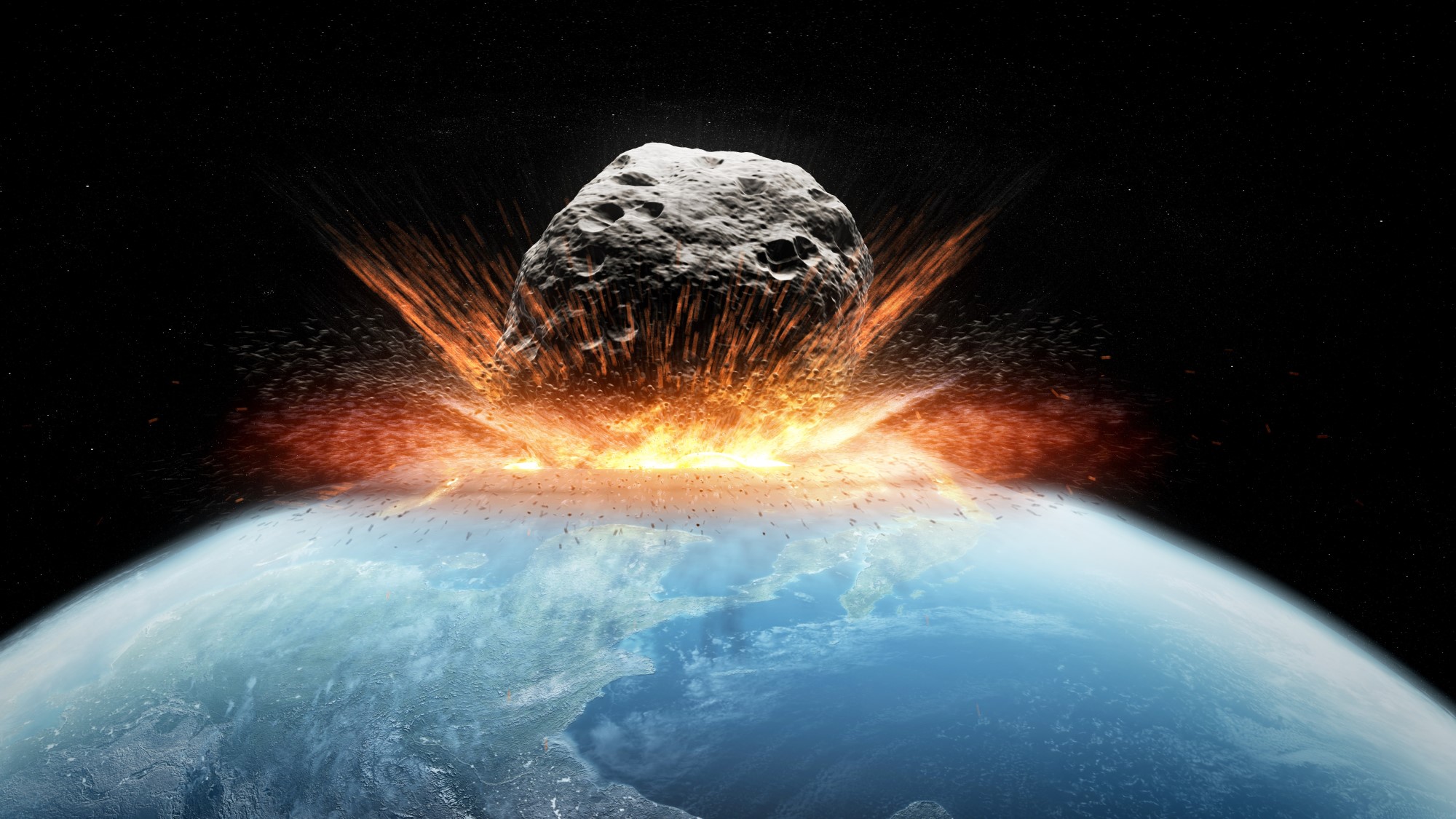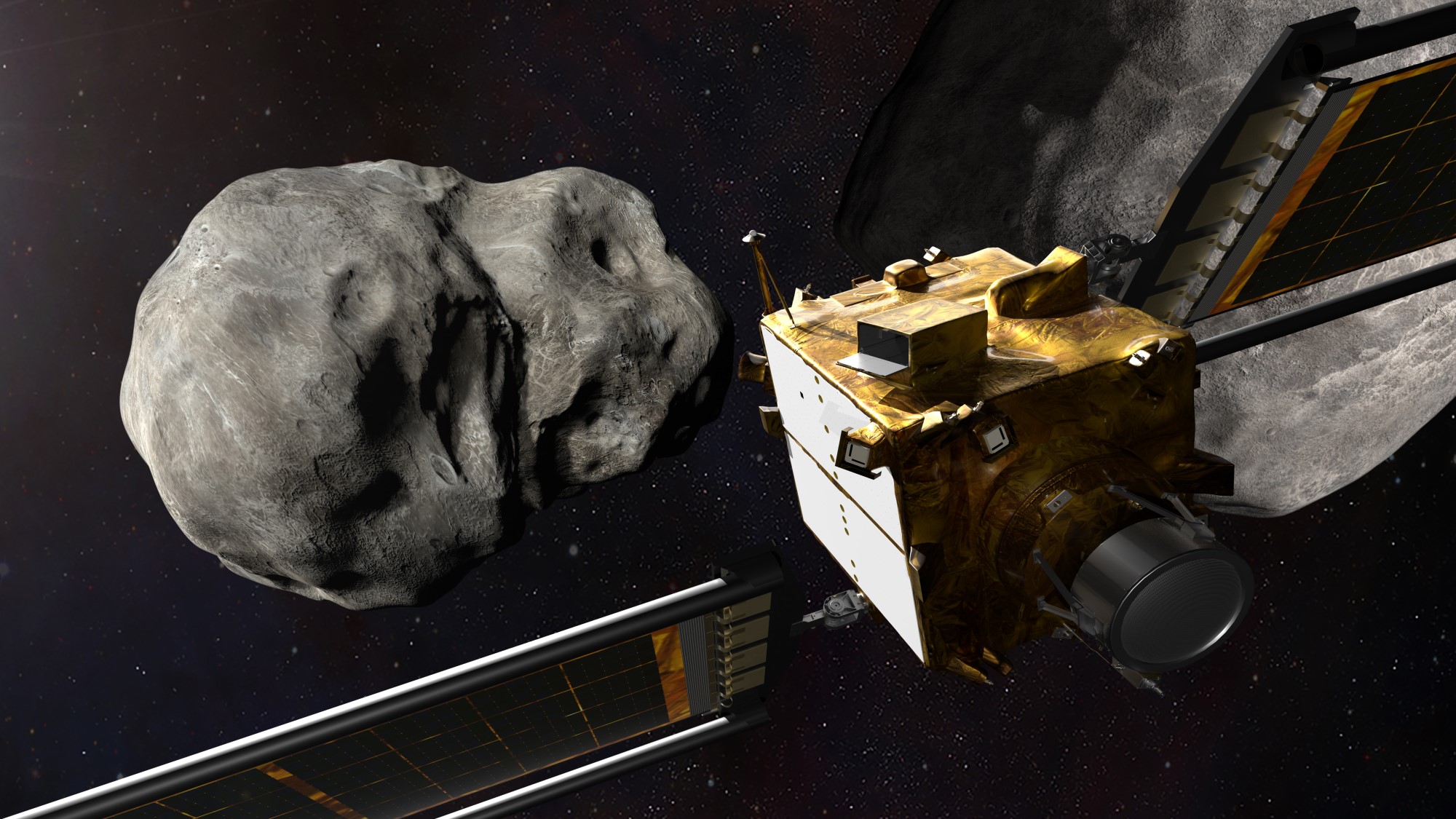NASA's DART asteroid-impact mission will be a key test of planetary defense
The DART impact could be just the start of a program testing techniques to deflect asteroids.

When NASA's Double Asteroid Redirection Test (DART) slams into the tiny asteroid Dimorphos, it will be our first attempt to demonstrate our ability to deflect dangerous incoming asteroids.
For decades, scientists around the world have been scanning the sky, searching for potentially hazardous asteroids in the vicinity of Earth. And as astronomers discover near-Earth asteroids in ever greater numbers, attention is now turning toward how we might protect Earth should an asteroid on a collision course be discovered. One technique is brute force, and to test it, DART will collide with the 560-foot-wide (170 m) Dimorphos at 7:14 p.m. EDT (2314 GMT) on Sept. 26.
Dimorphos is a member of a binary system with another asteroid, the 2,600-foot-wide (780 m) Didymos, making it the ideal target with which to measure our deflection capabilities. DART's so-called "kinetic impact" will alter Dimorphos' orbit around Didymos, and because the two rocks are gravitationally bound, there's no chance that the impact could send Dimorphos accidentally careening across space.
Related: The greatest asteroid missions of all time!
The experiment marks a change of pace for NASA, which has to date focused its spacecraft on science. However, according to Lindley Johnson, the director of NASA's Planetary Defense Coordination Office, the DART mission does not signify a change in policy of thinking about hazardous objects, but rather a continuation of the work done so far.
"Our charter from the beginning has been not only to find asteroids, but to work on the technology and techniques that can be used to deflect an asteroid from an impact trajectory, should we ever find one," he told Space.com. "DART is just a first test in what we see as an ongoing program."
DART's roots go back 20 years, to when scientists at the European Space Agency considered a kinetic impactor mission called 'Don Quijote' (named after the eponymous knight in the famous Spanish novel). Although that particular mission never came to pass, in 2011, representatives from NASA and ESA discussed a potential joint deflection mission called AIM (Asteroid Impact Mission). That evolved into two independent but connected missions: DART and the European Space Agency's Hera mission, which will follow up on DART, visiting Didymos and Dimorphos in 2026 to view the aftermath of the impact and conduct a scientific study of the double-asteroid system.
Get the Space.com Newsletter
Breaking space news, the latest updates on rocket launches, skywatching events and more!
Should DART prove successful, planetary scientists view it as just the beginning of our efforts to learn how to defend Earth from hazardous asteroids.
"We'll certainly look to do tests in the future, whether it's against a different type of asteroid, or to test another technique, such as a gravity tractor," Johnson said. A gravity tractor involves parking a large spacecraft next to an asteroid. The spacecraft, though small compared to the asteroid, would have enough gravity to pull the asteroid toward it. Firing an ion engine, the tractor would in theory be able to pull the asteroid away from a collision course with Earth.

Alternatively, the thrust from an ion engine could also nudge a small asteroid away from Earth. Or solar reflectors placed on the surface of an asteroid could use sunlight to push the space rock away.
"There are lots of ideas out there," Johnson said.
However, while these methods of deflection should work for smaller, Dimorphos-scale asteroids, shifting larger asteroids will require a bigger punch. Being able to deflect an asteroid 0.6 miles wide (1 kilometer) would "be the dream," according to Patrick Michel, a scientist at the French National Center for Scientific Research (CNRS) and the principal investigator on the Hera mission.
But he's dubious that we could deflect such a large asteroid using just a kinetic impactor. "I don't think that would work because it's too big," he told Space.com.
So what might work against a larger asteroid? "We have a threshold in size where we have to mention the 'bad word': nuclear," Michel said. "So much energy would be needed to move a kilometer-sized asteroid that only a nuclear device can provide it. The good thing is that we know almost all the 1-kilometer objects and none are threatening to us, at least over the next century."
In theory that gives us time, although it is possible that an asteroid could still be discovered on a collision course, given that there are still significant numbers of these space rocks to find.
Astronomers predict that there are about 25,000 sizable objects that cross Earth's orbit. Of those larger than 0.6 miles (1 kilometer) in diameter that could threaten civilization if they impacted, about 97% have been discovered. For smaller ones, 460 feet (140 meters) across or larger and that could do significant regional damage should they collide with Earth, an estimated 42% have been found so far. None have been found to be on a collision course with Earth, at least not in the next century or so.
And scientists are still looking, with numerous ground- and space-based observatories contributing. The Pan-STARRS telescopes in Hawaii and the Catalina Sky Survey in Arizona are both funded by NASA to conduct searches for near-Earth asteroids, and the Vera C. Rubin Observatory in Chile will also play its part when it begins science operations later this decade. In space, NASA's NEOWISE mission — a new purpose given to the old Wide-field Infrared Survey Explorer spacecraft, has led the charge, finding thousands of asteroids.
Together, these searches are now finding on average about 500 sizable near-Earth objects (NEOs) each year, according to NASA. But of the 25,000 suspected near-Earth asteroids larger than 460 feet, only about 10,000 have been identified so far, meaning that at the current rate of discovery, it will take another 30 years to find them all.
In an attempt to speed things up, NASA plans to launch the NEO Surveyor mission no sooner than 2026. As an infrared space telescope, NEO Surveyor will search for and characterize all the dangerous asteroids and comets larger than 460 feet that venture within 30 million miles (50 million km) of Earth.
"NEO Surveyor is designed to find the remaining population of asteroids within 10 years," Johnson said.
And while DART is the first mission to try to deflect an asteroid, space agencies around the world have been visiting asteroids over the years. NASA's NEARShoemaker mission visited and landed on the near-Earth asteroid Eros in 2001, and JAXA's Hayabusa and Hayabusa2 sample-return missions visited the near-Earth asteroids Itokawa and Ryugu. NASA's OSIRIS-REx mission is currently bringing home samples from asteroid Bennu, and of course Hera will join the ranks after launching in 2024. These missions are characterizing different kinds of near-Earth asteroids and determining their composition and internal structure, all of which helps inform how well deflection missions might work.
For now, however, all eyes are on DART and its rendezvous with Didymos and Dimorphos on Sept. 26. If the mission works as planned — and that's still a big 'if,' — then it will give us confidence that humans have a viable method for protecting Earth.
Follow Keith Cooper on Twitter @21stCenturySETI. Follow us on Twitter @Spacedotcom and on Facebook.
Join our Space Forums to keep talking space on the latest missions, night sky and more! And if you have a news tip, correction or comment, let us know at: community@space.com.

Keith Cooper is a freelance science journalist and editor in the United Kingdom, and has a degree in physics and astrophysics from the University of Manchester. He's the author of "The Contact Paradox: Challenging Our Assumptions in the Search for Extraterrestrial Intelligence" (Bloomsbury Sigma, 2020) and has written articles on astronomy, space, physics and astrobiology for a multitude of magazines and websites.









